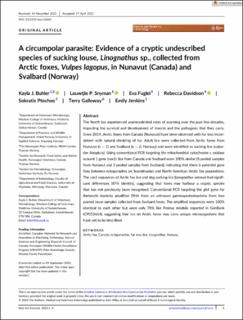| dc.contributor.author | Buhler, Kayla J. | |
| dc.contributor.author | Snyman, Louwtjie P. | |
| dc.contributor.author | Fuglei, Eva | |
| dc.contributor.author | Davidson, Rebecca K. | |
| dc.contributor.author | Ptochos, Sokratis | |
| dc.contributor.author | Galloway, Terry | |
| dc.contributor.author | Jenkins, Emily | |
| dc.coverage.spatial | Canada | en_US |
| dc.date.accessioned | 2023-10-04T07:22:55Z | |
| dc.date.available | 2023-10-04T07:22:55Z | |
| dc.date.created | 2023-06-12T13:33:54Z | |
| dc.date.issued | 2023 | |
| dc.identifier.citation | Medical and Veterinary Entomology. 2023, . | en_US |
| dc.identifier.issn | 0269-283X | |
| dc.identifier.uri | https://hdl.handle.net/11250/3094002 | |
| dc.description.abstract | The North has experienced unprecedented rates of warming over the past few decades, impacting the survival and development of insects and the pathogens that they carry. Since 2019, Arctic foxes from Canada (Nunavut) have been observed with fur loss inconsistent with natural shedding of fur. Adult lice were collected from Arctic foxes from Nunavut (n = 1) and Svalbard (n = 2; Norway) and were identified as sucking lice (suborder Anoplura). Using conventional PCR targeting the mitochondrial cytochrome c oxidase subunit 1 gene (cox1), lice from Canada and Svalbard were 100% similar (8 pooled samples from Nunavut and 3 pooled samples from Svalbard), indicating that there is potential gene flow between ectoparasites on Scandinavian and North American Arctic fox populations. The cox1 sequences of Arctic fox lice and dog sucking lice (Linognathus setosus) had significant differences (87% identity), suggesting that foxes may harbour a cryptic species that has not previously been recognised. Conventional PCR targeting the gltA gene for Bartonella bacteria amplified DNA from an unknown gammaproteobacteria from two pooled louse samples collected from Svalbard foxes. The amplified sequences were 100% identical to each other but were only 78% like Proteus mirabilis reported in GenBank (CP053614), suggesting that lice on Arctic foxes may carry unique microorganisms that have yet to be described. | en_US |
| dc.language.iso | eng | en_US |
| dc.rights | Attribution-NonCommercial-NoDerivatives 4.0 Internasjonal | * |
| dc.rights.uri | http://creativecommons.org/licenses/by-nc-nd/4.0/deed.no | * |
| dc.subject | arctic fox | en_US |
| dc.subject | Canada | en_US |
| dc.subject | ectoparasites | en_US |
| dc.subject | fur loss | en_US |
| dc.subject | lice | en_US |
| dc.subject | Linognathus | en_US |
| dc.subject | Norway | en_US |
| dc.title | A circumpolar parasite: Evidence of a cryptic undescribed species of sucking louse, Linognathus sp., collected from Arctic foxes, Vulpes lagopus, in Nunavut (Canada) and Svalbard (Norway) | en_US |
| dc.type | Peer reviewed | en_US |
| dc.type | Journal article | en_US |
| dc.description.version | publishedVersion | en_US |
| dc.rights.holder | © 2023 The Authors. | en_US |
| dc.subject.nsi | VDP::Matematikk og Naturvitenskap: 400::Zoologiske og botaniske fag: 480::Parasittologi: 484 | en_US |
| dc.source.pagenumber | 9 | en_US |
| dc.source.journal | Medical and Veterinary Entomology | en_US |
| dc.identifier.doi | 10.1111/mve.12665 | |
| dc.identifier.cristin | 2153797 | |
| cristin.ispublished | true | |
| cristin.fulltext | original | |
| cristin.qualitycode | 1 | |

